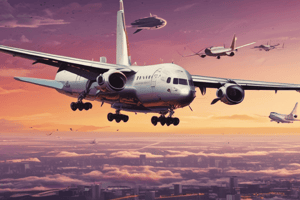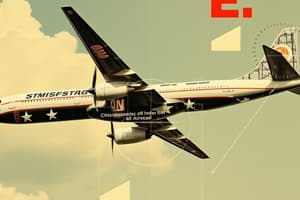Podcast
Questions and Answers
What is the primary purpose of Restricted Areas?
What is the primary purpose of Restricted Areas?
- To separate IFR traffic from all types of aerial activities.
- To warn pilots of potential hazardous activities.
- To allow military training and activities under controlled conditions. (correct)
- To completely prohibit any aircraft from entering.
How does a Warning Area differ from Restricted Airspace?
How does a Warning Area differ from Restricted Airspace?
- Warning Areas extend into international waters and warn of hazards. (correct)
- Warning Areas require pilots to seek explicit permission for entry.
- Warning Areas are only situated inland and not over water.
- Warning Areas are always restricted and cannot be entered.
What are Military Operations Areas (MOAs) primarily used for?
What are Military Operations Areas (MOAs) primarily used for?
- To completely restrict civilian flights in the area.
- To separate military training from IFR traffic. (correct)
- To establish a safe zone for aerial photography.
- To conduct civilian flight training without interference.
What is notable about Controlled Firing Areas (CFAs)?
What is notable about Controlled Firing Areas (CFAs)?
What does an Alert Area indicate?
What does an Alert Area indicate?
Why are National Security Areas (NSAs) established?
Why are National Security Areas (NSAs) established?
How are Military Operations Areas (MOAs) usually indicated on charts?
How are Military Operations Areas (MOAs) usually indicated on charts?
What is required for an aircraft to enter a Restricted Area?
What is required for an aircraft to enter a Restricted Area?
What characterizes the activities in Controlled Firing Areas?
What characterizes the activities in Controlled Firing Areas?
What should pilots generally do when approaching an Alert Area?
What should pilots generally do when approaching an Alert Area?
Entrance to Restricted Areas is allowed without permission if they are not being utilized for their designated purpose.
Entrance to Restricted Areas is allowed without permission if they are not being utilized for their designated purpose.
Warning Areas extend only to two nautical miles from the coast of the United States.
Warning Areas extend only to two nautical miles from the coast of the United States.
Military Operations Areas (MOAs) are depicted on charts with the letters 'MA'.
Military Operations Areas (MOAs) are depicted on charts with the letters 'MA'.
Controlled Firing Areas (CFAs) are charted for pilots to be aware of hazardous activities.
Controlled Firing Areas (CFAs) are charted for pilots to be aware of hazardous activities.
National Security Areas (NSAs) require pilots to avoid flying through them voluntarily.
National Security Areas (NSAs) require pilots to avoid flying through them voluntarily.
Alert Areas are designated for low-volume pilot training and are depicted on charts with an 'A' followed by a number.
Alert Areas are designated for low-volume pilot training and are depicted on charts with an 'A' followed by a number.
Military Operations Areas can be either active or inactive, with schedules published through NOTAMs.
Military Operations Areas can be either active or inactive, with schedules published through NOTAMs.
Warning Areas warn pilots of collisions with aircraft participating in training exercises.
Warning Areas warn pilots of collisions with aircraft participating in training exercises.
All aircraft can fly freely through Controlled Firing Areas as they are managed by ground personnel.
All aircraft can fly freely through Controlled Firing Areas as they are managed by ground personnel.
Restricted Areas are completely off-limits for any aircraft to enter at all times.
Restricted Areas are completely off-limits for any aircraft to enter at all times.
In which type of SUA are hazardous activities conducted, but not charted, and instead controlled by radar or lookout?
In which type of SUA are hazardous activities conducted, but not charted, and instead controlled by radar or lookout?
What type of aerial activity is typically present in an area designated as an Alert Area?
What type of aerial activity is typically present in an area designated as an Alert Area?
What is the primary purpose of National Security Areas (NSAs)?
What is the primary purpose of National Security Areas (NSAs)?
What warning do pilots receive when entering a Warning Area?
What warning do pilots receive when entering a Warning Area?
What permission is required for an aircraft to enter a Restricted Area?
What permission is required for an aircraft to enter a Restricted Area?
What type of aircraft are present in Military Operations Areas (MOAs)?
What type of aircraft are present in Military Operations Areas (MOAs)?
Why are Controlled Firing Areas (CFAs) not charted?
Why are Controlled Firing Areas (CFAs) not charted?
What type of activities are conducted in Restricted Areas?
What type of activities are conducted in Restricted Areas?
What is the purpose of charting Military Operations Areas (MOAs)?
What is the purpose of charting Military Operations Areas (MOAs)?
What is the general difference between Restricted Areas and Warning Areas?
What is the general difference between Restricted Areas and Warning Areas?
Flashcards are hidden until you start studying
Study Notes
Introduction to Special Use Airspace (SUA)
- Special Use Airspace (SUA) is designated for specific activities that may impose restrictions on aircraft operations.
- SUAs enhance safety, protect national assets, and facilitate special activities.
Categories of Special Use Airspace
-
Prohibited Areas: Completely restricted airspace where all aircraft are forbidden to enter due to national security; depicted as "P" followed by a number (e.g., P-40).
-
Restricted Areas: Airspace where flight is allowed but with restrictions; includes dangerous activities like military training. Entrance requires permission when the area is inactive.
-
Warning Areas: Extend from the U.S. coastline into international waters, warning pilots of potential hazards in the area.
-
Military Operations Areas (MOAs): Separate military training activities from Instrument Flight Rules (IFR) traffic; depicted as "MOA". These can be active or inactive, with schedules available through NOTAMs.
-
Alert Areas: High volume of pilot training or unusual aerial activities. Depicted with an "A" followed by a number; all aircraft can enter but should be vigilant.
-
Controlled Firing Areas (CFAs): Activities that are hazardous if not controlled; not charted but monitored via radar or lookout.
-
National Security Areas (NSAs): Established for increased security around sensitive locations; pilots are encouraged to avoid these areas voluntarily.
Importance of Understanding SUA
-
Awareness of SUA is crucial for safe flight planning and navigation.
-
SUAs are integral to maintaining safety in the skies and managing air traffic effectively.
-
Pilots need to know SUA locations, activity status, and potential impacts on flight paths for compliance and safety.
Conclusion and Next Steps
- Understanding SUAs enhances a pilot's ability to navigate complex airspace and ensures mission accomplishment while protecting national interests and safety.
- Next focus will be on the specific purposes and impacts of each type of Special Use Airspace.
Special Use Airspace (SUA) Overview
- Defined as areas where flight activities are restricted due to their nature or the potential danger they pose to non-participating aircraft.
- SUAs facilitate special activities, enhance safety, and protect national assets.
Categories of Special Use Airspace
- Prohibited Areas: No entry allowed due to national security concerns; e.g., flying over the White House.
- Restricted Areas: Contain hazardous activities such as military training; entry is allowed with permission when inactive.
- Warning Areas: Extend from the U.S. coastline into international waters, alerting pilots to potential hazards.
- Military Operations Areas (MOAs): Separate military training from civilian air traffic; require pilots to exercise caution.
- Alert Areas: High volumes of pilot training or unusual aerial activities; not strictly regulated but require vigilance from pilots.
- Controlled Firing Areas (CFAs): Activities are controlled, and safety measures allow for operating without rerouting non-participating aircraft.
- National Security Areas (NSAs): Increased security measures for ground facilities; pilots are encouraged to avoid these areas voluntarily.
Importance of Understanding SUAs
- Essential for flight operations and compliance with regulations, impacting safety and navigation.
- SUAs are highlighted on sectional charts, providing critical information for flight planning including operating hours and altitudes.
Flight Planning Implications
- Pilots must review sectional charts to identify intersecting SUAs when planning routes.
- Adjustments in timing or rerouting may be necessary if an SUA is active during the planned flight.
- Example: A flight path through an MOA that is inactive at the time allows for passage without modification.
Purpose of Special Use Airspace
- Established for national security to protect sensitive areas and support military training and operations safely.
- Environmental protection measures to safeguard wildlife and ecosystems from low-level flying.
- Enhances flight safety by segregating risky activities from general aviation traffic.
- Aids in managing air traffic flow, especially in busy airspace above major hubs.
Typical Activities in SUAs
- Include aerobatic flights, military training, and research missions requiring isolated airspace for sensitive operations.
- Understanding these activities is crucial for pilots to navigate safely and efficiently in the vicinity of SUAs.
Summary of Special Use Airspace Functions
- Provides a framework for conducting military and other specialized activities while minimizing risks to civilian aircraft.
- Essential knowledge for future pilots to ensure safe navigation and operational compliance in diverse flight scenarios.
Special Use Airspace (SUA) Overview
- Special Use Airspace (SUA) designates regions with restrictions to protect activities or enhance safety.
- Essential for pilots to understand SUA to navigate securely and comply with regulations.
Categories of Special Use Airspace
-
Prohibited Areas:
- No aircraft can enter due to national security concerns, e.g., airspace over the White House.
- Marked on charts with a "P" followed by a number (e.g., P-40).
-
Restricted Areas:
- Flight is allowed with limitations but may be hazardous due to military exercises or similar activities.
- Requires permission from the controlling agency when active.
-
Warning Areas:
- Extends from the U.S. coastline into international waters, indicating potential hazards.
- Functions as a caution for pilots entering risk-prone areas.
-
Military Operations Areas (MOAs):
- Designated for military training, separating military maneuvers from civil air traffic.
- Active or inactive status requires pilots to consult NOTAMs for operational hours.
-
Alert Areas:
- High volumes of pilot training or unusual aerial activities take place here.
- Depicted with an "A" followed by a number on charts, pilots should be particularly cautious.
-
Controlled Firing Areas (CFAs):
- Specific activities may pose risks but are not charted since they are suspended when aircraft are present.
- Ensures the safety of non-participating aircraft through active monitoring.
-
National Security Areas (NSAs):
- Established for enhanced safety and security near critical ground facilities.
- Pilots are advised to avoid these areas voluntarily.
Importance for Flight Operations
- Thorough knowledge of SUA facilitates safe navigation and aids in efficient flight planning.
- Charting includes operating hours, altitudes, and controlling agency details, critical for operational compliance.
Practical Application in Flight Planning
- Pilots must assess sectional charts for SUA that intersect with intended flight routes.
- Adjustments to flight path, clearance requests, or timing changes may be necessary based on SUA activity.
- Example: If an MOA is active, pilots must reroute or reschedule their flight to maintain safety.
Conclusion and Future Learning
- SUA understanding is pivotal for maintaining airspace safety and executing regulatory practices.
- Upcoming discussions will cover the purpose and impact of SUAs within the aviation community, vital for future pilots.
Studying That Suits You
Use AI to generate personalized quizzes and flashcards to suit your learning preferences.




